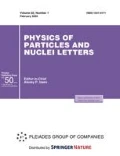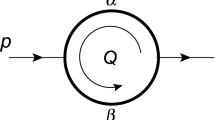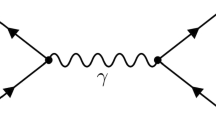Abstract
Feynman amplitudes in perturbative quantum field theory are being expressed in terms of an algebra of functions, extending the familiar logarithms, and associated numbers—periods. The study of these functions (including hyperlogarithms) and numbers (like the multiple zeta values), that dates back to Leibniz and Euler, has attracted anew the interest of algebraic geometers and number theorists during the last decades. The two originally independent developments are recently coming together in an unlikely collaboration between particle physics and what were regarded as the most abstruse branches of mathematics.
Similar content being viewed by others
References
L. Adams, C. Bogner, and S. Weinzierl, “A walk on the sunset boulevard,” arXiv:1601.03646 [hep-ph].
S. Bloch, M. Kerr, and P. Vanhove, “Local mirror symmetry and the sunset Feynman integral,” arXiv:1601.08181.
C. Bogner and S. Weinzierl, “Periods and Feynman integrals,” J. Math. Phys. 50, 042302 (2009); arXiv:0711.4863v2 [hep-th].
D. J. Broadhurst and D. Kreimer, “Knots and numbers in ?4 to 7 loops and beyond,” Int. J. Mod. Phys. C 6, 519–524 (1995); “Association of multiple zeta values with positive knots via feynman diagrams up to 9 loops,” Phys. Lett. B 393, 403–412 (1997); arXiv:hep-th/9609128.
F. Brown, “Single-valued hyperlogarithms and unipotent differential equations,” IHES Notes (2004), available online.
F. Brown, “Iterated integrals in quantum field theory,” in Geometric and Topological Methods for Quantum Field Theory, Proceedings of the 2009 Summer School (Cambridge Univ. Press, Cambridge, 2013), pp. 188–240.
F. Brown, “On the decomposition of motivic multiple zeta values,” in Galois-Teichmüller Theory Arithmetic Geometry, Ed. by H. Nakamura, F. Pop, L. Schneps, A. Tamogawa, Adv. Studies Pure Math. 63, 31–58 (2012); arXiv:1102.1310v2[math.NT].
F. Brown, “Mixed tate motives over Z,” Ann. Math. 175, 949–976 (2012); arXiv:1102.1312[math.AG].
F. Brown, “Feynman integrals and cosmic galois group,” arXiv:1512.06409v2[math-ph]; “Notes on motivic periods,” arXiv:1512.06410[math.NT]; “Periods and Feynman amplitudes,” arXiv:1512.09265[math.ph].
S. Carr, H. Gangle, and L. Schneps, “On the Broadhurst-Kreimer generating series for multiple zeta values,” in Proceedings of the Madrid-ICMAT Conference on Multizetas, 2015.
K. T. Chen, “Iterated path integrals,” Bull. Am. Math. Soc. 83, 831–879 (1977).
P. Deligne, “Multizetas d’aprés Francis Brown,” Séminaire Bourbaki 64, No. 1048 (2012).
C. Duhr, “Mathematical aspects of scattering amplitudes,” arXiv:1411.7538 [hep-ph].
G. Galilei, “First day,” in Dialogue Concerning the Two Chief World Systems (1632).
J. K. Golden, A. B. Goncharov, M. Spradlin, C. Vergu, and A. Volovich, “Motivic amplitudes and cluster coordinates,” arXiv:1305.1617 [hep-th].
A. Goncharov, “Galois symmetry of fundamental groupoids and noncommutative geometry,” Duke Math. J. 128, 209–284 (2005); arXiv:math/0208144v4.
B. Hayes, “g-ology,” Am. Sci. 92, 212–216 (2004).
T. Kinoshita, “Tenth-order QED contribution to the electron and high precision test of quantum electrodynamics,” in Proceedings of the Conference in Honor of the 90th Birthday of Freeman Dyson (World Scientific, Singapore, 2014), pp. 148–172.
M. Kontsevich and D. Zagier, “Periods,” in Mathematics–20101 and Beyond, Ed. by B. Engquist and W. Schmid (Springer, Berlin, 2001), pp. 771–808.
S. Laporta and E. Remiddi, “The analytical value of the electron g-2 at order a3 in QED,” Phys. Lett. B 379, 283–291 (1996); arXiv:hep-ph/9602417.
B. E. Lautrup, A. Peterman, and E. de Rafael, “Recent developments in the comparison between theory and experiment in quantum electrodynamics,” Phys. Rep. 3, 193–260 (1972).
N. M. Nikolov, R. Stora, and I. Todorov, “Renormalization of massless Feynman amplitudes as an extension problem for associate homogeneous distributions,” Rev. Math. Phys. 26, 1430002 (2014); CERN-TH-PH/2013-107; arXiv:1307.6854 [hep-th].
E. Panzer and O. Schnetz, “The galois coaction on ?4 periods,” arXiv:1604.04289 [hep-th].
L. Schneps, Survey of the Theory of Multiple Zeta Values (Heilbronn, Bristol, 2011).
O. Schnetz, “Quantum periods: a census of f4-transcendentals,” J. Number Theory Phys. 4, 1–48 (2010); arXiv:0801.2856v2[hep-th].
O. Schnetz, “Graphical functions and single-valued multiple polylogarithms,” Commun. Number Theory Phys. 8, 589–685 (2014); arXiv:1302.6445v2[math.NT].
I. Todorov, “Polylogarithms and multizeta values in massless Feynman amplitudes,” in Lie Theory and Its Applications in Physics LT10, Ed. by V. Dobrev, Vol. 111 of Springer Proceedings in Mathematics and Statistics (Springer, Tokyo, 2014), pp. 155–176; IHES/P/14/10 (Bures-sur-Yvette, 2014).
I. Todorov, “Perturbative quantum field theory meets number theory 2014,” in ICMAT Research Trimester. Multiple Zeta Values, Multiple Polylogarithms and Quantum Field Theory, Springer Proceedings in Mathematics and Statistics (Springer, 2017); IHES/P/16/02.
I. Todorov, “Hyperlogarithms and periods in Feynman amplitudes,” Report on the International Conference on Lie Theory and Its Applications in Physics LT’11, Varna, Bulgaria, 2015; CERN-TH-2016-042.
M. Waldschmidt, Lectures on Multiple Zeta Values (Inst. Math. Sci., Chennai, India, 2011).
A. Weil, “Prehistory of the zeta-function,” in Number Theory, Trace Formula and Discrete Groups (Academic Press, New York, 1989), pp. 1–9; Number Theory—An Approach through History from Hammurapi to Legendre (Birkhäuser, Basel, 1983,2007).
Don Zagier, Introduction to Modular Forms, in From Number Theory to Physics, Proceedings of the Les Houches Meeting, March 1989, Ed. by M. Waldschmidt (Springer, Berlin, 1992), pp. 238–291.
Don Zagier, “The dilogarithm function,” in Frontiers in Number Theory, Physics and Geometry II, Ed. by P. Cartier, B. Julia, P. Moussa, and P. Vanhove (Springer, Berlin, 2006), pp. 3–65.
J. Zhao, “Multiple polylogarithms,” in Proceeding of the Workshop Polylogarithms as a Bridge between Number Theory and Particle Physics, Durham, July 3–13, 2013.
Author information
Authors and Affiliations
Corresponding author
Additional information
Invited talk at the International Workshop “Supersymmetries and Quantum Symmetries” (SQS’2015), 3–8 August, 2015
The article is published in the original.
Rights and permissions
About this article
Cite this article
Todorov, I. Number theory meets high energy physics. Phys. Part. Nuclei Lett. 14, 291–297 (2017). https://doi.org/10.1134/S1547477117020339
Received:
Published:
Issue Date:
DOI: https://doi.org/10.1134/S1547477117020339




